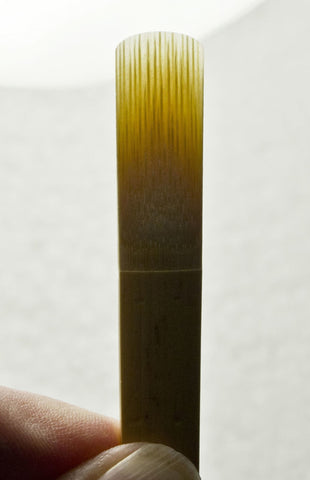How to find the Perfect Reed

Ever been baffled what reed to choose? Here's some tips to help navigate the complex world of reeds...
MOST single reed players will agree that the number of different makes and variations of reed available today is quite comprehensive, with a new one appearing almost on a monthly basis it seems, so choosing a reed can sometimes be a case of trial and error.
Before looking at all the reeds, have a clear idea what you want your reed for. Are you looking for a reed suitable for Jazz, Big Band, Rock, or are you playing more Classical, Symphonic Wind Band? This should certainly influence your choice of reed brand and make it a less overwhelming selection. Once you're down to this, consider your budget, read their specification and do read product reviews to get other user experiences on them.
Once you have made your choice of reed strength and brand, what do you look for in the individual reed? Here are a couple of suggestions.
Visually, check that the tip of the reed has been cut symmetrically and there are no splits or other damage by gently running your finger along the underside tip of the reed...

Next, by holding the reed to a light, check that the fibre or grain of the reed runs parallel to the cut of the reed, also the heart of the reed is central to the face of the reed and not to one side...

A few words regarding reed management. On occasion I have heard people say “I bought a box of reeds and had to throw half of them away because they didn’t work!” Remember, reeds are made of an organic material and will change over a period of time. Also, humidity can influence the way a reed performs. So, don’t throw those reeds away, you may come back to them at a later date and find that they play fine.
Customising your reeds, i.e. scraping and clipping, is something that a lot of players, understandably, approach with a certain amount of trepidation. There are various items on the market, such as reed trimmers and re-surfacers that are designed to help you make the most of your reeds. I would suggest experimenting on old reeds to discover what effect adjusting the different areas of the reed might have. Soak a piece of reed rush below for a few minutes and the tube will collapse allowing the player to make fine adjustments to reeds, similar to sanding.
Finally, I am often asked what reed I would recommend, very difficult to answer as there are so many factors that would affect that choice. Among them are the physical make up of the player, the genre of music and also the mouthpiece, including tip opening etc.
Whatever reed you decide to play, it’s a good bet that you will always be looking for a better one! Good luck!”


